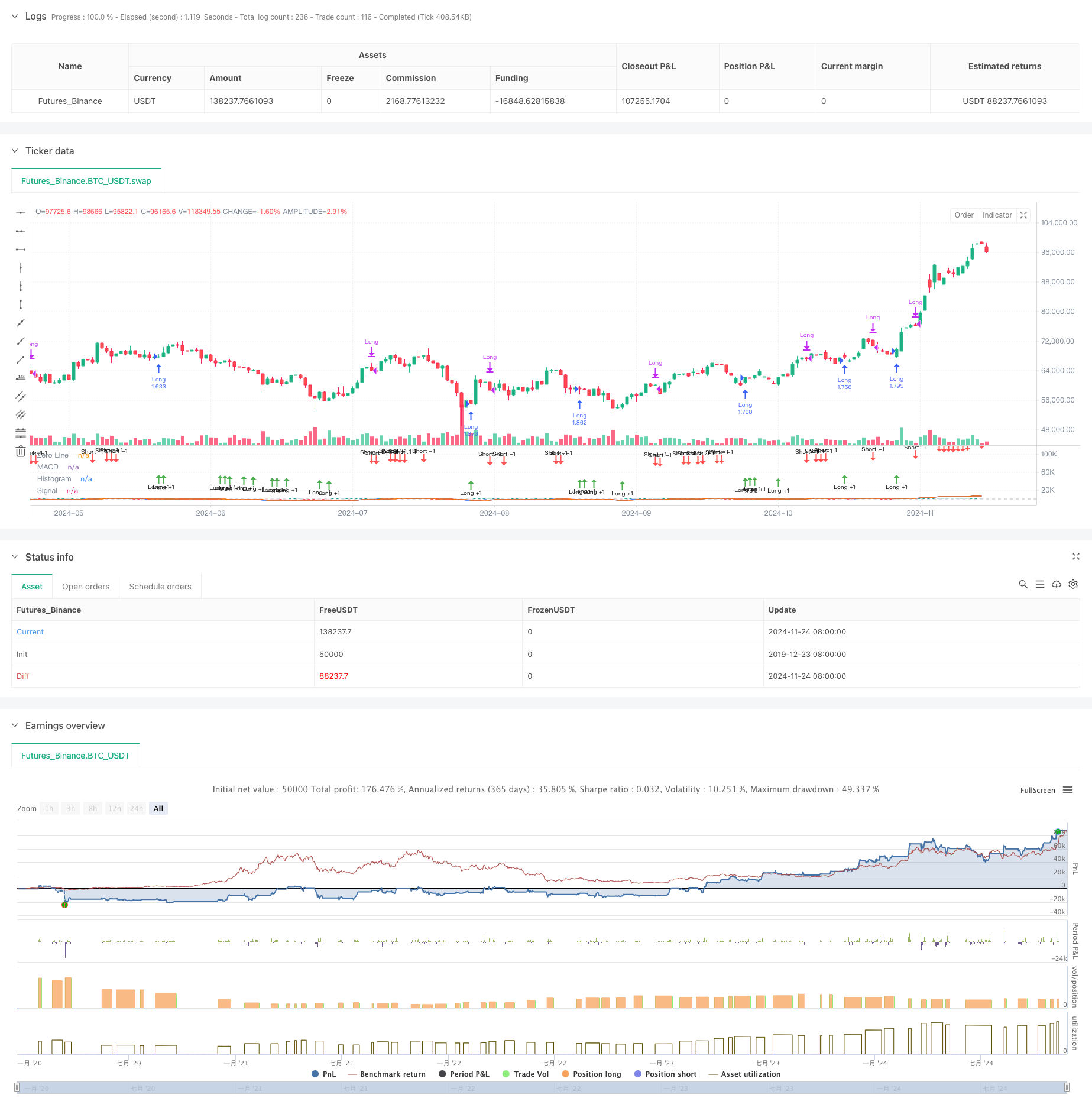
概述
本策略基于MACD(移动平均收敛发散指标)的动态变化特征进行交易决策。策略的核心在于通过观察MACD柱状图(Histogram)的变化趋势来预测可能出现的金叉和死叉,从而提前布局交易。该策略不仅关注传统的MACD指标交叉信号,更注重柱状图的动态变化特征,通过提前预判交叉信号的方式来获取更优的入场时机。
策略原理
策略采用改良版的MACD指标系统,包含快速移动平均线(EMA12)和慢速移动平均线(EMA26)的差值计算,以及基于2周期的信号线。核心交易逻辑基于以下几个关键点: 1. 通过计算柱状图的变化率(hist_change)来判断趋势的动态变化 2. 当柱状图为负且连续三个周期呈现上升趋势时,预判可能出现金叉信号,提前入场做多 3. 当柱状图为正且连续三个周期呈现下降趋势时,预判可能出现死叉信号,平仓出场 4. 策略引入时间过滤机制,只在指定的时间范围内进行交易
策略优势
- 信号预判性强:通过观察柱状图的动态变化提前预测可能出现的交叉信号,有效提高入场时机
- 风险控制合理:设置了0.1%的手续费和3个滑点的交易成本,符合实际交易环境
- 资金管理灵活:采用账户总值的百分比进行仓位管理,有效控制风险
- 可视化效果优秀:使用不同颜色标注柱状图涨跌,并通过箭头标注交易信号,便于分析
策略风险
- 假突破风险:在横盘震荡市场中可能出现频繁的假突破信号
- 滞后性风险:虽然采用预判机制,但MACD本身仍具有一定滞后性
- 市场环境依赖:策略在趋势明显的市场中表现更佳,而在震荡市场中可能表现欠佳
- 参数敏感性:快慢线周期的设置对策略表现影响较大
策略优化方向
- 引入市场环境过滤:可添加趋势判断指标,在不同市场环境下采用不同的交易参数
- 优化仓位管理:可根据信号强度动态调整持仓比例
- 完善止损机制:添加追踪止损或固定止损以控制回撤
- 增加信号确认机制:结合其他技术指标进行交叉验证,提高信号可靠性
- 优化参数选择:可采用自适应参数方法,根据市场状况动态调整指标参数
总结
该策略通过创新性地运用MACD柱状图的动态变化特征,实现了对传统MACD交易系统的改良和优化。策略的预判机制能够提供更早的入场信号,而严格的交易条件和风险控制措施则确保了策略的稳定性。通过进一步优化和完善,该策略有望在实际交易中取得更好的表现。
策略源码
/*backtest
start: 2019-12-23 08:00:00
end: 2024-11-25 08:00:00
period: 1d
basePeriod: 1d
exchanges: [{"eid":"Futures_Binance","currency":"BTC_USDT"}]
*/
//@version=5
strategy(title="Demo GPT - Moving Average Convergence Divergence", shorttitle="MACD", commission_type=strategy.commission.percent, commission_value=0.1, slippage=3, default_qty_type=strategy.percent_of_equity, default_qty_value=100)
// Getting inputs
fast_length = input(title="Fast Length", defval=12)
slow_length = input(title="Slow Length", defval=26)
src = input(title="Source", defval=close)
signal_length = input.int(title="Signal Smoothing", minval=1, maxval=50, defval=2) // Set smoothing line to 2
sma_source = input.string(title="Oscillator MA Type", defval="EMA", options=["SMA", "EMA"])
sma_signal = input.string(title="Signal Line MA Type", defval="EMA", options=["SMA", "EMA"])
// Date inputs
start_date = input(title="Start Date", defval=timestamp("2018-01-01T00:00:00"))
end_date = input(title="End Date", defval=timestamp("2069-12-31T23:59:59"))
// Calculating
fast_ma = sma_source == "SMA" ? ta.sma(src, fast_length) : ta.ema(src, fast_length)
slow_ma = sma_source == "SMA" ? ta.sma(src, slow_length) : ta.ema(src, slow_length)
macd = fast_ma - slow_ma
signal = sma_signal == "SMA" ? ta.sma(macd, signal_length) : ta.ema(macd, signal_length)
hist = macd - signal
// Strategy logic
isInDateRange = true
// Calculate the rate of change of the histogram
hist_change = hist - hist[1]
// Anticipate a bullish crossover: histogram is negative, increasing, and approaching zero
anticipate_long = isInDateRange and hist < 0 and hist_change > 0 and hist > hist[1] and hist > hist[2]
// Anticipate an exit (bearish crossover): histogram is positive, decreasing, and approaching zero
anticipate_exit = isInDateRange and hist > 0 and hist_change < 0 and hist < hist[1] and hist < hist[2]
if anticipate_long
strategy.entry("Long", strategy.long)
if anticipate_exit
strategy.close("Long")
// Plotting
hline(0, "Zero Line", color=color.new(#787B86, 50))
plot(hist, title="Histogram", style=plot.style_columns, color=(hist >= 0 ? (hist > hist[1] ? #26A69A : #B2DFDB) : (hist < hist[1] ? #FF5252 : #FFCDD2)))
plot(macd, title="MACD", color=#2962FF)
plot(signal, title="Signal", color=#FF6D00)
// Plotting arrows when anticipating the crossover
plotshape(anticipate_long, title="Long +1", location=location.belowbar, color=color.green, style=shape.arrowup, size=size.tiny, text="Long +1")
plotshape(anticipate_exit, title="Short -1", location=location.abovebar, color=color.red, style=shape.arrowdown, size=size.tiny, text="Short -1")
相关推荐